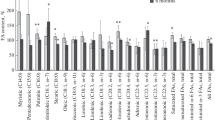Summary
This investigation decided to answer the question of the origin of fatty acids for the increased synthesis of triglycerides in acute ethanolinduced hyperlipoproteinemia. Healthy persons ingested 0.5 g of ethanol/kg body weight initially and 0,15 g of ethanol/kg and hour for 12 hours. The fatty acids of plasma triglycerides were determined before and after ingestion of ethanol in persons fasting and nourished isocaloricaly, with and without blocking peripheral lipolysis by nicotinic acid and with addition of glucose. The fasting persons triglycerides fatty acids increased to 165.7 % of the initial value after 12 hours of ethanol ingestion, with a preferential increase in palmitic-, oleic- and stearic acid. When lipolysis in adipose tissue was blocked by 0.5 g of nicotinic adic/hour the triglyceridefatty acids reached only 116.2 % after 12 hours, with a decrease in oleic acid, which is present in adipose tissue to a higher degree than in plasma triglycerides. When nourished isocaloricaly, the enhancement of plasma triglyceride-fatty acids could not be suppressed by nicotinic acid. The changes in concentration and pattern of triglyceride-fatty acids announce that the fatty acids used for increased synthesis of triglycerides in fasting persons come from adipose tissue preferentially. In contrast ethanol-ingested hyperlipoproteinemia during ingestion of a food which cannot be suppressed by nicotinic acid, seems to originate from fatty acids of the food and for de novo synthesis of fatty acids in the liver.
Zusammenfassung
Die vorliegende Untersuchung galt der Frage nach dem Ursprung der Fettsäuren für die gesteigerte Triglyceridsynthese bei der äthanolinduzierten Hyperlipidämie. Zur Prüfung erhielten gesunde Versuchspersonen 0,5 g Äthanol/kg Sollgewicht initial sowie 0,15 g Äthanol/kg Sollgewicht jede weitere Stunde. Bestimmt wurden die Triglycerid-Fettsäuren bei fastenden und isokalorisch ernährten Probanden mit und ohne Blockierung der Lipolyse mit Hilfe von Nikotinsäure und Glukose. Bei fastenden Versuchspersonen, die nur Äthanol erhielten, steigen die Triglycerid-Fettsäuren auf 165,7 % nach 12 Stunden an, wobei die Palmitin-, Öl- und Stearinsäure besonders stark zunehmen. Bei gleichzeitiger Blockierung der Lipolyse mit 0,5 g Nikotinsäure/Stunde steigen die Triglycerid-Fettsäuren nach 12 Stunden nur auf 116,2 % an, wobei die im Fettgewebe in höherem Anteil als im Serum vorhandene Ölsäure sogar deutlich abfällt. Im Gegensatz zu den Befunden bei fastenden Probanden konnte unter isokalorischer Ernährung die Vermehrung der Serumtriglyceride durch Nikotinsäure nicht unterdrückt werden. Die Veränderungen der Triglycerid-Gesamtfettsäuren und die Verschiebungen im Fettsäuremuster sprechen dafür, daß die Fettsäuren für die gesteigerte Triglyceridsynthese bei fastenden Probanden überwiegend aus dem Depotfett stammen. Die durch Nikotinsäure nicht unterdrückbare äthanolbedingte Hyperlipidämie bei Nahrungsaufnahme läßt die Deutung zu, daß die Fettsäuren unter diesen Bedingungen ihren Ursprung in den Nahrungsfetten und der de novo Fettsäuresynthese haben.
Similar content being viewed by others
Literatur
ABELIN, I., HERREN, C., BERLI, W.: Helv. med. Acta25 591 (1958)
BARBORIAK, J.J., MEADE, R.C.: Atherosclerosis13 199 (1971)
BJÖRNTROP, P.: Metabolism14 836 (1965)
BLOMSTRAND, R., KAGER, L., LANTTO, O.: Life Sciences13 1131 (1973)
BODE, C., GOEBELL, H.: Klin. Wschr.49 1201 (1971)
BRODIE, B.B., BUTLER, W.M., HORNING, M.G., MAICKEL, R.P., MALING, M.M.: Amer. J. Clin. Nutr.9 432 (1961)
CARLSON, L.A., ORÖ, L.: Acta med. scand.172 641 (1962)
EBERHAGEN, D.: Zeitschr. analyt. Chemie212 230 (1965)
ESTLER, C.-J., AMMON, H.P.T.: Arch. int. Pharmacodyn.166 333 (1967)
FEIGL, J.: Biochem. Z.92 282 (1918)
FOLCH, J., LEES, M.: J. biol. Chem.226 497 (1957)
FRÖBERG, S., ORÖ, L.: Acta med. scand.174 635 (1963)
HOLLENBERG, C.H., ANGEL, A.: Amer. J. Physiol.205 909 (1963)
HORNING, M.G., WILLIAMS, E.A., MALING, H.M., BRODIE, B.B.: Biochem. Biophys. Res. Commun.3 635 (1960)
ISSELBACHER, K.J., GREENBERGER, N.J.: New Engl. J. Med.270 351 (1964)
JONES, D.P., LOSOWSKY, M.S.: J. clin. Invest.42 945 (1963)
KAFFARNIK, H., SCHNEIDER, J.: Z. ges. exp. Med.152 187 (1970)
KLINGMANN, G.J., GODALL, Mc.C.: J. Pharmacol. (Exp. Ther.)121 313 (1957)
LIEBER, C.S., SCHMID, R.: J. clin. Invest.40 394 (1961)
LIEBER, C.S., SPITZ, N.: J. clin. Invest.45 1400 (1966)
LIEBER, C.S., SPITZ, N., DECARLI, L.M.: J. clin. Invest.45 51 (1966)
LIEBER, C.S.: Gastroenterology50 119 (1966)
LOSOWSKY, M.S., JONES, D.P., DAVIDSON, C.S., LIEBER, C.S.: Amer. J. Med.35 794 (1963)
MADISON, L.L., LOCHNER, A., WULFF, J.: Diabetes16 252 (1967)
MALING, H.M., HORNING, M.G., BUTLER, W.M. jr., HIGHMAN, B., BRODIE, B.B.: Fed. Proc.19 229 (1960)
MALLOV, S., BLOCH, J.L.: Amer. J. Physiol.184 29 (1956)
MÜHLFELLNER, G., MÜHLFELLNER, O., KAFFARNIK, H.: Z. ges. exp. Med.154 22 (1971)
MÜHLFELLNER, G., MENZEL, H., MÜHFELLNER, O., SCHUBOTZ, R., ZÖFEL, P., KAFFARNIK, H.: Wien. klin. Wschr. (im Druck)
OETTE, K., FISCHEL, P., PHLIPPEN, R.: In: Alkohol und Leber (Hrsg. W. Gerok, K. Sickinger, H.H. Hennekeuser. Stuttgart: Schattauer Verlag 1971
OETTE, K.: Res. exp. Med.162 185 (1974)
PERMAN, E.S.: Acta physiol. scand.44 241 (1958)
REBOUCAS, G., ISSELBACHER, K.J.: J. clin. Invest.40 1355 (1961)
SCHAPIRO, R.H., SCHEIG, R.L., DRUMMEY, G.D., MENDELSON, J.H., ISSELBACHER, K.J.: New Engl. J. Med.272 610 (1965)
SCHUBOTZ, R.: Diagnostik (im Druck)
SCHULZE, B., KAFFARNIK, H.: Klin. Wschr.48 1147 (1970)
SICKINGER, K.: Habil-Schrift, Göttingen 1967
SICKINGER, K.: Klin. Wschr.46 563 (1968)
ZÖLLNER, N., WOLFRAM, G.: Klin. Wschr.40 1101 (1962)
Author information
Authors and Affiliations
Additional information
Mit Unterstützung der Deutschen Forschungsgemeinschaft
Herrn Prof. Dr. G.A. MARTINI zum 60. Geburtstag gewidmet
Rights and permissions
About this article
Cite this article
Schubotz, R., Mühlfellner, G., Schneider, J. et al. Verhalten der Triglycerid-Fettsäuren bei fastenden und isokalorisch ernährten Versuchspersonen unter akuter Äthanolbelastung. Einfluß der Lipolysehemmung durch Nikotinsäure und Glucose. Res. Exp. Med. 167, 139–148 (1976). https://doi.org/10.1007/BF01851595
Received:
Issue Date:
DOI: https://doi.org/10.1007/BF01851595



